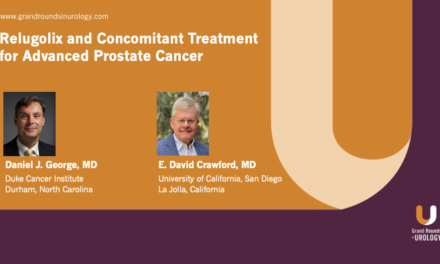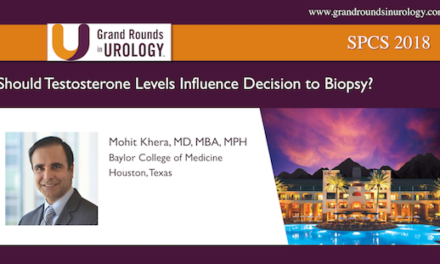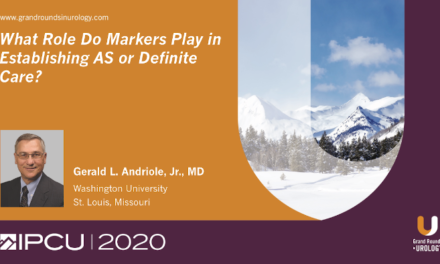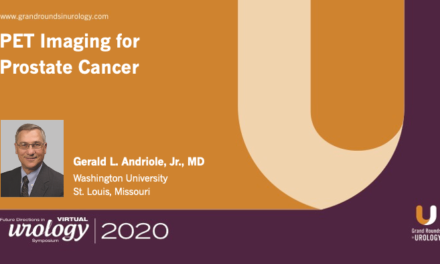Dr. Nelson N. Stone spoke at the 24th International Prostate Cancer Update on Thursday, February 20, 2014 on “Adjuvant and Salvage Radiotherapy After Prostatectomy: A Review of the 2013 ASTRO/AUA Guidelines” In his presentation, Dr. Stone discusses the 2013 ASTRO/AUA Guidelines, and informing patients of the benefits of adjuvant to radiation therapy.
Presentation:
Keywords: adjuvant radiation therapy, AUA, Gleason score, perineural invasion
Cite: How to cite: Stone, Nelson N. “Adjuvant and Salvage Radiotherapy After Prostatectomy: A Review of the 2013 ASTRO/AUA Guidelines.” Grand Rounds in Urology. January 12, 2015. Accessed Apr 2024 https://dev.grandroundsinurology.com/prostate-cancer-nelson-n-stone-adjuvant-and-salvage-radiotherapy/.
Transcript
Adjuvant and Salvage Radiotherapy After Prostatectomy: A Review of the 2013 ASTRO/AUA Guidelines
So let’s have the first question, and this is more of a clinical case and some questions associated with it. A 71-year-old with a PSA increase from 3.5 to 4.6 over one year, prostate exam is normal, the prostate volume is 36, the TRUS biopsy is 12.4, one core is positive with 45% Gleason score of six, 11 cores are negative.
So the PSAD is about .13, IPSS is seven, SHIM is 14, what do you recommend for this patient? He should have a prostatectomy; we’ll give him external beam; brachytherapy; looks like a good candidate for active surveillance; or maybe we should investigate him further. Now, I put down transperitoneal mapping biopsy; you can substitute multiparameter MRI if you like instead. So please select your choice.
Okay. Let’s go on. I don’t do, we don’t do multiparameter MRIs at my institution. But we do, have been doing transperitoneal mapping biopsies for several years. So we had 55 cores taken, and five cores came out with a Gleason eight involving 15-100% of the cores.
So the question now is pertinent to the lecture, although we started out with a case. So with this type of pathology on the biopsy specimens, obviously, you’re going to recommend something more aggressive, so this patient decides to have a radical prostatectomy. So the question now is what’s the likelihood of a positive margin, extracapsular extension, or seminal vesicle involvement based on these biopsy results?
So the correct answer is number four. So I want to go over the guidelines now, and I’m going to focus on what we really need to pay attention regarding the new guidelines for adjuvant radiation therapy. And so, we’ll focus on the impact of adverse clinical features. We’re also going to focus a little bit on the impact of case volume, specifically now since most of our radicals are done by the robotic, and we’ll talk a little bit about is, are we really sure we want to do adjuvant, or maybe it really should be salvage when the PSA is going up a little bit. And what about adding androgen withdrawal therapy into the mix?
So patients, so this is the guide, these are the guidelines, and I’m going to break the guidelines down into specific components. And the first component I want to look at is, and this is for discussion with the patients because that’s what the guidelines are aimed for, you’re going to be, once the diagnosis is made and you decide to do a prostatectomy, and that’s what the patient wants, and the patient has a certain type of PSA or biopsy result, how are you going to break down the discussion?
Now, remember, what you say to the patient and how he receives it is going to be the end result. So it’s the presentation that’s important here, and I think this is what both the AUA and ASTRO, because this is a combined effort, are trying to get at.
So the first component of the guidelines have to deal with the potential: what’s the potential based on what the patient is presenting with to have adverse pathological condition? It’s not the result; it’s the potential. That’s the first part of the discussion.
So again, this comes from the guidelines, and when we look at adverse pathological conditions, the reason why we want, or the AUA moved to this situation about adjuvant radiation therapy is because the consequences of a radical prostatectomy that results in adverse pathological conditions means that 60% of the patients are going to suffer biochemical recurrence at five years. That’s the impotence. So the purpose of the guidelines is for the potential.
So let’s look at some of the data. And there’s lots of ways to do this. You could use nomograms, you could use online calculators: they’re all going to give you the same results. So if you’re just looking at the PSA, and this one paper from Bill Catalonus series, if the PSA is over ten, the likelihood of having organ confined disease is 60%. So as a single variable, PSA over ten, 40% of the patients are going to have adverse pathological conditions to meet the criteria.
If you’re just looking at Gleason score, in this study from the Mayo Clinic with a Gleason score of seven, 74% of the 1700 patients had a 3+4 and the rest had 4+3, the median PSA was 7.5 for the 3+4’s and slightly higher, 8.8, for through 4+3’s. Looking at the Gleason score 4+3, on the biopsy, 45% had a T3, 40% had positive margins.
Now, it doesn’t have to be the worst case scenario, which was seminal vesicle invasion, because any of these would get you into the discussion phase, remember, discussion phase, the potential, to tell the patient, okay, you had a Gleason 4+3 on your biopsy, you have a 45% risk of having a feature that would lead then to the discussion about whether or not you’re going to have adjuvant radiation.
This, it’s important to recognize that the discussion comes before the surgery. It’s not, okay, we took out your prostate, now you’re got a positive margin, let’s talk about radiation; the discussion has to come before you actually do the intervention.
This was a paper that came out recently. It was 2009, 119 patients with Gleason 8-10. Organ confined disease was found in 20% of the patients. So if your patient has a Gleason 8-10, 80% of the patients are going to have features that may suggest the need for radiation therapy. So that’s why the correct answer was the last one: high risk features. The overwhelming majority, 75% and above, are going to have an adverse outcome regarding pathological features.
And this is data from Memorial Sloan Kettering looking at the Gleason 8-10. It was 65% that were non-organ confined, and this is just different ways to look at it. Like I said, you can use any number of systems, but it’s really pretty easy. PSAs over ten, it’s about 50%. Gleasons 4+3, it’s about 50-60%. Gleasons 8-10, it’s about 80%. So if you’re sitting in your office, those are easy numbers to remember when you discuss with the patient the potential for adverse pathological features.
Now, there have been a number of studies. This is one from Thomas Jaffe from Dr. Gomella’s institution where they didn’t, it’s not a randomized study, but it was a quick look at the high risk patients, the Gleason seven, PT3, 45 had adjuvant radiation, 31 were observed, and on the multivariate analysis, it was both the margin positivity and the use of adjuvant radiation therapy that influenced whether or not the patients were likely to fail.
Now, we’re all familiar with Gleason score, PSA, and clinical stage. But I think it’s also to consider the influence of perineural invasion. Now, perineural invasion has to be a strict definition, pathological definition: the cancer actually has to invade the nerve space to hit that definition. I think that this has fallen out of favor recently, in recent years, but it’s always been an important factor.
It was a very important factor for me when we first designed the brachytherapy program at Mount Sinai because we were doing lateral node dissections on every patient that came for brachytherapy because we wanted to model it similar to a radical. And when we sat down and looked at the pathological features present on the biopsy that would indicate the risk of positive nodes, perineural invasion was a significant factor in that.
So we know that over the years, so you see here the years, it was ’94-2005, the incidence of perineural invasion has decreased from 44% to 24% in this one study. And that goes along with the fact that tumor volume has gone down over time.
But when you look at the contribution from perineural invasion in this one study in terms of whether or not it influences the decision to use postoperative radiation, those patients who had it on their biopsies, 51% had an indication for having perineural invasion, and that result actually translated, whether it was low risk or intermediate or high risk, these low risk patients, 43% had perineural invasion. And when the prostates came out, there was an indication and it was high risk; it was up to 81%.
So it’s another thing to consider when you’re sitting with the patients: he’s a Gleason 3+4, his PSA is eight or nine, but yet, his biopsy has perineural invasion. That’s another factor you might want to discuss with the patient and advise him that this may lead to a higher likelihood of having an adverse pathological outcome.
Now, what about experience? This was a French study, 22,000+ patients who had open prostatectomy, laparoscopic or robotic. The institution with the most is here in the R1, had almost 3000 robotics, so a great experience, and the institution with the least had 32.
Now, these were all blinded as to what institution they were, but if you look down here, R8 versus R1, the odds ratio of having a positive margin for the high volume centers versus the lower volume centers was sixfold. So if you’re a urologist who is relatively new at the robotic, and I’m not going to define whether it has 100 cases or 2000 cases because everybody’s skill set is different, you might want to add that into the mix that you tell your patient, I have done 200 robots and the data suggests that that may lead to a higher risk of positive margins.
Okay, so that’s the potential. Now we’re going to get on to the actual need to have radiation, what’s the data show? So the guidelines say patients with adverse pathological findings should be informed that adjuvant radiotherapy compared to prostatectomy alone reduces the risk of biochemical recurrence.
There was also a sort of out here, and that is they should also be informed that the impact of the radiation on metastases and overall survival is less clear. So that’s your decision; that’s how I started this talk. You have to decide how you want to talk to your patients. You can say, well, it’s just PSA recurrence; it’s not survival. But I think we all know if a patient has a PSA relapse, even though he may not die from his disease, he’s probably going to eventually go on hormonal therapy, and that has its own set of risks.
But Dr. King, a radiation oncologist, has done a lot of work to try and model radiation therapy, waiting, salvage versus adjuvant, and dose. So he put together this review; it’s not a meta analysis. But if you look at the data on adjuvant therapy, on salvage therapy up here, and the cut point, the median cut point for the decision to give radiation therapy, so 1.4 PSA, .7, 1.3, .5, and the median five-year BNAD for biochemical failure, it averages around 50%. And if you looked at the three randomized studies with adjuvant radiation therapy versus the salvage, it averages about 70%. So it’s about a 20% difference in biochemical control when radiotherapy is given much earlier on, in this case, in the adjuvant setting.
And this, he put together this little graph based on the existing data trying to show that you lose 4% in BNAD for every .1 nm increase in PSA, so starting here in the adjuvant and moving over to a rising PSA to make your decision as to whether or not to give radiotherapy, you will see what the drop is based on the data. And even if you chose down here the 0.2, which is what many people choose because it’s the cut point for failure, you have already lost about 15% in BNAD.
So the next guideline, physician should offer radiotherapy to patients with adverse features with positive seminal vesicles, surgical margins because of the demonstrated reduction in biochemical recurrence. So this is the actual guideline, just it’s an evidence strength of grade A. So what’s the basis for having such a strong guideline?
And that is based on the meta analysis of the three randomized studies: the Boler study from the ERTC, the SWOG study, and the ARO, the more recent study. And it’s amazing, they all came in very similar. Here is a Forest plot showing the roughly 50% advantage on biochemical control for the three studies. And when you look at the total, the hazard ratio is .48, meaning there’s a 52% improvement in control.
Well, there’s no free rides there, so as part of the guidelines, you also have to discuss with your patients the potential risk of getting adjuvant radiation therapy. So these data are the three studies combined, and you see the ranges because they’re three different studies. These are the acute toxicities. Grade one and grade two, you really don’t care about; it’s the grade three and four that are more serious. So grade three to four, 2-8% genitourinary and zero to 2% gastrointestinal.
I’m not so concerned about the acute toxicities because patients get over them, but it’s the late toxicities that are our problem. And with the genitourinary was zero to 10%, these are mostly irritative voiding symptoms and strictures, and the gastrointestinal zero to 6.7% grade three to four, which would be mostly rectal ulcers.
Keep in mind that this data was accumulated many years ago. Most of it was conformal therapy or even four field therapy. Almost none of it was IMRT, and none of it, zero was IGRT. It was what we use today, and studies have shown the new technology has greatly reduced the side effects. But nonetheless, these are in the guidelines because that’s the randomized data we have, and you have to share the potential risks with the patient.
One thing we should not say, this is also in the guidelines, that if I give you radiation therapy after your prostatectomy, your incontinence will get worse. That has never been demonstrated, and the guidelines actually say do not tell the patients that that happens.
Sexual function is a little more difficult because there’s not a lot of good data, keeping in mind you’re already probably thinking you’re doing no nerve sparing, or at the most, unilateral, so probably the majority of the patients are not going to have sexual function anyway. So the radiation therapy is less of an issue in terms of preserving erectile function, and that’s what the guidelines say.
This is a summary of the guidelines, the three studies. Also keep in mind, and this is important, the radiation dose was 60 Gy when these studies were done. So that’s an old, very old dose, and we’re going to have a question about what we should give today.
Will the data be better if we give higher doses in an adjuvant setting? Now, it takes more radiation to get rid of a Gleason eight because you have residual disease, especially if you have a lot of it, and that’s going to be interesting to find out with future studies.
Still not everybody is convinced that adjuvant therapy is the best. So we have a number of randomized trials, the RADICAL trials, the RAVE trials, and the GETOG trials, that are looking at adjuvant radiotherapy versus salvage radiotherapy where the salvage point, the time for salvage is picked for the individual studies. In the RADICAL studies, it’s a PSA cut point of .1. In the RAVE study, it’s .2. In the GETOG study, it’s again .2. So we will see once these studies mature, which is going to take a while, whether there really is an issue between adjuvant and salvage.
I remember very early on, I think Tom Stami taught me this so many years ago when we first started PSA, one cubic centimeter of cancer equals about 1 nm of PSA. So if you’re talking about 0.1 ng, that’s 100 million cells sitting somewhere around the prostate bed, and do you really want to wait until 100 million cells that are Gleason eight has a chance to pop up on your radar because the patient’s at a PSA of .1? So that’s something to think about. But the proof will be is there any difference between adjuvant and salvage once these studies get completed?
Now, I said something about the dose. Remember the dose was very low in those early studies. So this was also modeled by Dr. King looking at the likelihood of relapse in the salvage setting versus the dose of radiation given. So here you see dose of radiation was around 60 Gy for the adjuvant studies that led to the guidelines. And as you bump up the dose, up to the higher levels, you’ll get a substantial improvement in relapse-free survival with higher doses of radiation delivered in the salvage setting.
There’s also three studies ongoing that are looking at the addition of androgen deprivation therapy when patients have high risk pathological features along with the radiation therapy. And these studies are ongoing. One was started in 1996, so we should have some study, some data from RTOG fairly soon on the advantages of adding ADT in the salvage or adjuvant setting. These are all salvage studies.
So in conclusion, evidence favors the use of, right now, adjuvant therapy over salvage therapy. The guidelines require patients to be informed of the benefit of adjuvant to radiation when adverse pathological features are present. The counseling should be tailored to the individuals because not every patient is the same, so the discussion will vary based on what the patient has. And ongoing randomized trials should better define whether radiation can be given with very low PSA recurrences, and whether or not that will be as effective as adjuvant radiation and whether androgen withdrawal therapy may further benefit the outcomes for these patients. Thank you.
Okay, I think we have time for a question, post-lecture question. I’m going to show one here, okay? So a 63-year-old with Gleason score of seven has an RP and has extra-capillary extension with frank positive margins, no question about it. Patient decides to have adjuvant radiotherapy. What dose are you going to prescribe?
Now, we’ve got radiation oncologists here and I’ve got urologists in big groups that are affiliated with radiation centers, so this is an issue that we should know. Remember the randomized data is at 60 Gy. So choose the dose you’re going to give. So the majority will choose 72 Gy. There is no scientific basis to this answer. But one day, we’ll hopefully have an answer.
There was one question from the audience: how about a patient with a positive margin and T3V pathology? So seminal vesicle involvement. Now, when I was a resident, just a couple years ago, of course, we were trained, a patient has seminal vesicle involvement, that’s the same thing as metastatic disease. Why waste your time?
But in the SWOG study and in the ERTC study, those patients with T3V disease also had a 50% decrease in PSA recurrence, and in our experience, like I said very early on, we were very aggressive in trying to stage patients, so every patient had seminal vesicle biopsies in addition to lap node dissections before they got seed implant. And those patients who had a positive seminal vesicle biopsy and negative nodes, they got put on a protocol of two years of hormones, seed implant of the prostate and the seminal vesicles, followed by 45 Gy of external beam.
So there, I published this already, their ten-year biochemical control with a PSA of 0.2, so the same as the AUA definition, was 65%. So no, most patients still relapse with local disease even though they have T3B disease. So that’s the answer to the question.
References
Antenor JA1, Roehl KA, Eggener SE, et al. Preoperative PSA and progression-free survival after radical prostatectomy for Stage T1c disease. Urology. 2005 Jul;66(1):156-60. http://www.ncbi.nlm.nih.gov/pubmed/15992903
Bahler CD, Foster RS, Bihrle R, et al. Radical prostatectomy as initial monotherapy for patients with pathologically confirmed high-grade prostate cancer. BJU Int. 2010 May;105(10):1372-6. http://www.ncbi.nlm.nih.gov/pubmed/19863521
King CR. Adjuvant radiotherapy after prostatectomy: does waiting for a detectable prostate-specific antigen level make sense? Int J Radiat Oncol Biol Phys. 2011 May 1;80(1):1-3. http://www.ncbi.nlm.nih.gov/pubmed/21277112
King CR. Adjuvant versus salvage radiotherapy for high-risk prostate cancer patients. Semin Radiat Oncol. 2013 Jul;23(3):215-21. http://www.ncbi.nlm.nih.gov/pubmed/23763888
Lee IH, Roberts R, Shah RB, et al. Perineural invasion is a marker for pathologically advanced disease in localized prostate cancer. Int J Radiat Oncol Biol Phys. 2007 Jul 15;68(4):1059-64. http://www.ncbi.nlm.nih.gov/pubmed/17398032
Sooriakumaran P, Srivastava A, Shariat SF, et al. A Multinational, Multi-institutional Study Comparing Positive Surgical Margin Rates Among 22393 Open, Laparoscopic, and Robot-assisted Radical Prostatectomy Patients.
Eur Urol. 2014 Sep;66(3):450-6. http://www.ncbi.nlm.nih.gov/pubmed/24290695
Tollefson MK1, Leibovich BC, Slezak JM, et al Long-term prognostic significance of primary Gleason pattern in patients with Gleason score 7 prostate cancer: impact on prostate cancer specific survival. J Urol. 2006 Feb;175(2):547-51. http://www.ncbi.nlm.nih.gov/pubmed/16406993
Valicenti RK, Chervoneva I, Gomella LG. Importance of margin extent as a predictor of outcome after adjuvant radiotherapy for Gleason score 7 pT3N0 prostate cancer. Int J Radiat Oncol Biol Phys. 2004 Mar 15;58(4):1093-7. http://www.ncbi.nlm.nih.gov/pubmed/15001249
Valicenti RK, Thompson I Jr, Albertsen P, et al. Adjuvant and salvage radiation therapy after prostatectomy: American Society for Radiation Oncology/American Urological Association guidelines. Int J Radiat Oncol Biol Phys. 2013 Aug 1;86(5):822-8. http://www.ncbi.nlm.nih.gov/pubmed/23845839
Yossepowitch O, Eggener SE, Bianco FJ Jr, et al. Radical prostatectomy for clinically localized, high risk prostate cancer: critical analysis ofrisk assessment methods.
J Urol. 2007 Aug;178(2):493-9. http://www.ncbi.nlm.nih.gov/pubmed/17561152






